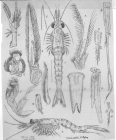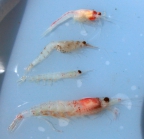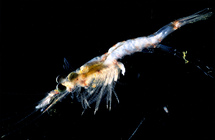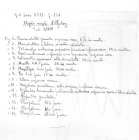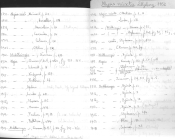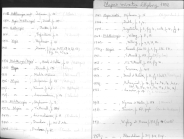
| Intro | | About | | Wiki | | Search traits | | Data explorer | | Literature | | Definitions | | Sources | | Webservices | | Statistics | | Feedback | | Editors | | Log in |
WoRMS taxon detailsMysis mixta Liljeborg, 1853
120113 (urn:lsid:marinespecies.org:taxname:120113)
accepted
Species
Mesomysis mixta (Liljeborg, 1853) · unaccepted > superseded combination (initially published by mistake)
Michtheimysis mixta (Liljeborg, 1853) · unaccepted > superseded combination
Mysis (Michtheimysis) mixta Liljeborg, 1853 · unaccepted > superseded combination (subgeneric division rejected)
Mysis latitans Krøyer, 1861 · unaccepted > junior subjective synonym
Onychomysis latitans (Krøyer, 1861) · unaccepted
marine, brackish,
Liljeborg, W. (1853). Hafs-Crustaceer vid Kullaberg. [Marine crustaceans at Kullaberg.]. <em>Öfversigt af Kongliga Vetenskaps-Akademiens Förhandlingar, (Norstedt, Stockholm).</em> 9(1)(1852): 1-13. [details]
Type locality contained in Swedish part of the Kattegat
type locality contained in Swedish part of the Kattegat [details]
Depth range 11-183m
Depth range 11-183m [details] Distribution In North America: Gulf of St. Lawrence (unspecified region), Saguenay Fjord, northern Gaspe waters, southern Gaspe waters...
Distribution In North America: Gulf of St. Lawrence (unspecified region), Saguenay Fjord, northern Gaspe waters, southern Gaspe waters (Baie des Chaleurs, Gaspe Bay to American, Orphan and Bradelle banks; eastern boundary: eastern Bradelle Valley), Magdalen Islands (from eastern Bradelle valley to the west, as far as Cape North, including the Cape Breton Channel), lower St. Lawrence estuary, middle North Shore (from Sept- Iles to Cape Whittle, including the Mingan Island), Laurentian Channel (bathyal zone)(=Honguedo Strait), lower North Shore, North and South slope of Anticosti Island, Prince Edward Island (from the northern tip of Miscou Island, N.B. to Cape Breton Island south of Cheticamp, including the Northumberland Strait and Georges Bay to the Canso Strait causeway); western slope of Newfoundland, including the southern part of the Strait of Belle Isle but excluding the upper 50m in the area southwest of Newfoundland; Cobscook Bay [details]
Mees, J.; Meland, K.; Väinölä, R. (Eds) (2012 onwards). World List of Lophogastrida, Stygiomysida and Mysida. Mysis mixta Liljeborg, 1853. Accessed through: World Register of Marine Species at: https://www.marinespecies.org/aphia.php?p=taxdetails&id=120113 on 2025-07-16
Date action by
Nomenclatureoriginal description
Liljeborg, W. (1853). Hafs-Crustaceer vid Kullaberg. [Marine crustaceans at Kullaberg.]. <em>Öfversigt af Kongliga Vetenskaps-Akademiens Förhandlingar, (Norstedt, Stockholm).</em> 9(1)(1852): 1-13. [details] original description (of Mysis latitans Krøyer, 1861) Krøyer, H. (1861). Et bidrag til kundskab om Krebsdyrfamilien Mysidae. <em>Naturhistorisk Tidsskrift Ser. III.</em> 1: 1-75, pls. 1-2. [details] basis of record van der Land, J.; Brattegard, T. (2001). Mysidacea. <em>In: Costello, M.J. et al. (Ed.) (2001). European register of marine species: a check-list of the marine species in Europe and a bibliography of guides to their identification. Collection Patrimoines Naturels.</em> 50: pp. 293-295. (look up in IMIS) [details] Otheradditional source
Brunel, P., L. Bosse & G. Lamarche. (1998). Catalogue of the marine invertebrates of the estuary and Gulf of St. Lawrence. <em>Canadian Special Publication of Fisheries and Aquatic Sciences, 126.</em> 405 pp. (look up in IMIS) [details] Available for editors
additional source Müller, H. G. (1993). World catalogue and bibliography of the recent Mysidacea. 238p. [details] Available for editors additional source Sars, G.O. (1869). Undersøgelser over Christiania-fjordens Dybvansfauna anstillede paa en i Sommeren 1868 foretagen Zoologisk Reise. <em>Nyt Magazin for Naturvidenskaberne.</em> 16: 305-362. (look up in IMIS) [details] additional source Tattersall, W.M.; Tattersall, O.S. (1951). The British Mysidacea. <em>Ray Society, London.</em> 1-460, figs. 1-118. (look up in IMIS) [details] Available for editors additional source Zimmer C. (1909): Die nordischen Schizopoden. K. Brandt & C. Apstein (eds.), Nordisches Plankton. Lipsius und Tischler, Kiel und Leipzig, 6: 1-178 [details] additional source Gordan, J. (1957). A bibliography of the order Mysidacea. <em>Bull. Am. Mus. Nat. Hist.</em> 112 (4): 281-393. [details] Available for editors additional source Tattersall, W. M. (1951). A review of the Mysidacea of the United States National Museum. <em>Smithsonian Institution United States National Museum Bulletin.</em> 201: 1-292., available online at https://play.google.com/store/books/details?id=-vhMAAAAYAAJ&rdid=book--vhMAAAAYAAJ [details] Available for editors additional source Zimmer, C. (1933). Mysidacea. <em>In: Grimpe, G. & E. Wagler, (eds.), Die Tierwelt der Nord- und Ostsee. Leipzig, Akad. Verlagsbuchhandl.</em> 23 (10): 26-69. [details] Available for editors additional source Lindstrom, M. (2000). Eye function of Mysidacea (Crustacea) in the northern Baltic Sea. <em>Journal of Experimental Marine Biology and Ecology.</em> 246: 85–101. [details] Available for editors additional source Stephensen, K. (1938). Euphausiacea, Mysidacea, Cumacea, and Nebaliacea. <em>In: Jensen, Ad. S., et al., (eds.), The zoology of Iceland. Copenhagen and Reykjavik, Levin & Munksgaard.</em> 3 (29): 1-24,1pl. [details] Available for editors additional source Macquart-Moulin, C.; Maycas, E. R. (1995). Inshore and offshore diel migrations in European benthopelagic mysids, genera Gastrosaccus , Anchialina and Haplostylus (Crustacea, Mysidacea). <em>Journal of Plankton Research.</em> 17(3): 531-555., available online at https://doi.org/10.1093/plankt/17.3.531 [details] Available for editors additional source Engström-Öst, J., M. Lehtiniemi, S. Green, B. Kozlowsky-Suzuki & M. Viitasalo. (2002). Does cyanobacterial toxin accumulate in mysid shrimps and fish via copepods?. <em>Journal of Experimental Marine Biology and Ecology.</em> 276(1-2): 95-107., available online at https://doi.org/10.1016/s0022-0981(02)00241-1 [details] Available for editors additional source Liljeborg, W. (1851). Norges Crustacéer. [Norway's Crustaceans.]. <em>Öfversigt af Kongliga, Vetenskaps-Akademiens Förhandlingar.</em> 8: 19-25., available online at https://www.biodiversitylibrary.org/page/15972015 [details] additional source Audzijonyte, A.; Damgaard, J.; Varvio, S.; Vainio, J. K.; Väinölä, R. (2005). Phylogeny of Mysis (Crustacea, Mysida): history of continental invasions inferred from molecular and morphological data. <em>Cladistics.</em> 21: 576-596. [details] Available for editors additional source Nyman, L., & L. Westin. 1969. A contribution to the methods of classification for some Mysidae and Gammarus species in the Baltic.-- Report (Sotvattenslaboratoriet (Sweden)) = Report - Institute of Freshwater Research (Drottningholm) 49: 157-163. [details] Available for editors additional source Petryashov, V. V. (1990). Reproduction and fecundity of mysids (Crustacea, Mysidacea) of Arctic Ocean and north-west Pacific.-- Trudy Zoologicheskogo Instituta = Travaux de l´Institut Zoologique de l´Académie des Sciences de l´URSS. <em>Works of the Zoological Institute.</em> 218: 140-160. [details] Available for editors additional source Poirier, L. 1969. Distribution horizontale et verticale des mysidacés à l'entrée de la Baie des Chaleurs en 1968.-- Rapp. Stn. Biol. mar. Grande-Rivière 1968: 67-76. [details] Available for editors additional source Richoux, N. B.; Deibel, D.; Thompson, R. J. (2004). Population biology of hyperbenthic crustaceans in a cold water environment (Conception Bay, Newfoundland). I. Mysis mixta (Mysidacea). <em>Marine Biology.</em> 144(5), 881-894. [details] Available for editors additional source Rudstam, L. G.; Danielsson, K.; Hansson, S.; Johansson, S. (1989). Diel vertical migration and feeding patterns of Mysis mixta (Crustacea, Mysidacea) in the Baltic Sea. <em>Marine Biology.</em> 101, 43-52. [details] Available for editors additional source Stephensen, K. (1933). The Godthaab expedition 1928. Schizopoda. <em>Meddel. Grønland.</em> 79 (9): 1-20. [details] Available for editors additional source Väinölä, R. (1992). The two Baltic species of the Mysis relicta species group. <em>In: Köhn, J., M.B. Jones, & A. Moffat (eds.), Taxonomy, Biology and Ecology of (Baltic) Mysids: Mysidacea: Crustacea): International Expert Conference, September 1991, Hiddensee, Germany. Rostock University.</em> 33-37. [details] Available for editors additional source Verslycke, T.; Fockedey, N.; McKenney, C. L.; Roast, S. D.; Jones, M. B.; Mees, J.; Janssen, C. R. (2004). Mysids as potential test organisms for the evaluation of environmental endocrine disruption: a review. <em>Environmental Toxicology and Chemistry.</em> 23(5), 1219-1234. [details] additional source Wigley, R. L.; Burns, B. R. (1971). Distribution and biology of mysids (Crustacea, Mysidacea) from the Atlantic coast of the U.S. in the NMFS Woods Hole collection. <em>Fish. Bull.</em> 69 (4): 717-746. [details] Available for editors additional source Apstein, C. (1906). Lebensgeschichte von Mysis mixta in der Ostsee. <em>Wiss. Meeresunters.</em> 9: 241-260. [details] additional source Astthorson, O. S. (1984). The distribution and biology of mysids in Icelandic subarctic waters as demonstrated by analysis of cod stomach contents. <em>Sarsia.</em> 69 (2): 107-116. [details] Available for editors additional source Astthorson, O. S. (1985). Mysids occuring in the stomachs of cod caught in the Atlantic water south and west of Iceland. <em>Sarsia.</em> 70 (2-3): 173-178. [details] Available for editors additional source Gorokhova, E. (2002). Moult cycle and its chronology in Mysis mixta and Neomysis integer (Crustacea, Mysidacea): implications for growth assessment. <em>Journal of Experimental Marine Biology and Ecology.</em> 278(2): 179-194., available online at https://doi.org/10.1016/s0022-0981(02)00333-7 [details] Available for editors additional source Engström, J.; Viherluoto, M.; Viitasalo, M. (2001). Effects of toxic and non-toxic cyanobacteria on grazing, zooplanktivory and survival of the mysid shrimp Mysis mixta. <em>Journal of Experimental Marine Biology and Ecology.</em> 257(2): 269-280., available online at https://doi.org/10.1016/s0022-0981(00)00339-7 [details] Available for editors additional source FIKSEN Ø, MACKENZIE BR (2002). Process-based models of feeding and prey selection in larval fish MEPS 243:151-164 : [details] Available for editors additional source GOROKHOVA E (1998). Exploring and modelling the growth dynamics of Mysis mixta Ecol Model 110:45-54 : [details] Available for editors additional source GOROKHOVA, E.; HANSSON, S. (1999). An experimental study on the variations in stable carbon and nitrogen isotopes fractionation during growth of Mysis mixta and Neomysis integer Can. J. Fish. Aquat. Sci., 56: 2203-2210 : [details] Available for editors additional source Hansen, H.J. (1887). Malacostraca marina Groenlandiae occidentalis. Oversigt over det vestlige Gronlands fauna af malakostrake havkrebsdyr. <em>Vidensk. Medd. Naturhist. For. Kjobenhaven.</em> ser. 4, vol. 9: 5-226,6 pls. [details] additional source HANSSON S, DE STASIO BT, GOROKHOVA E, MOHAMMADIAN MA (2001). Ratio-dependent functional responses - tests with the zooplanktivore Mysis mixta MEPS 216:181-189 : [details] Available for editors additional source Norkko, J.; Bonsdorff, E.; Norkko, A. (2000). Drifting algal mats as an alternative habitat for benthic invertebrates: Species specific responses to a transient resource. <em>Journal of Experimental Marine Biology and Ecology.</em> 248: 79-104. [details] Available for editors additional source JOHANNSSON, O. & LEGGETT M. & RUDSTAM, L. & SERVOS, M. & MOHAMMADIAN, M. & GAL, G. & DERMOTT R. &HESSLEIN, R. (2001). Diet of Mysis relicta in Lake Ontario as revealed by stable isotope and gut analysis Cann. J. Fish. Aquat. Sci. 58: 1975-1986 [details] Available for editors additional source KIBIRIGE I, PERISSINOTTO R, NOZAIS C (2003). Grazing rates and feeding preferences of the mysid shrimp Gastrosaccus brevifissura in a temporarily open estuary in South Africa MEPS, 251:201-210 : [details] Available for editors additional source KöHN, J.; JONES, M.B. (1991). Taxonomy, Biology and Ecology of (Baltic) Mysidacea International Expert Conference, Hiddensee, Germany [details] Available for editors additional source Lehtiniemi, M., J. Engström-Öst, M. Karjalainen, B. Kozlowsky-Suzuki & M. Viitasalo. (2002). Fate of cyanobacterial toxins in the pelagic food web: transfer to copepods or to faecal pellets?. <em>Marine Ecology Progress Series.</em> 241:13-21. [details] Available for editors additional source Mees, J.; Jones, M. B. (1997). The hyperbenthos. <em>Oceanography and marine Biology: an annual review.</em> 35: 221-255. (look up in IMIS) [details] Available for editors additional source Viherluoto, M.; Kuosa, H.; Flinkman, J.; Viitasalo, M. (2000). Food utilisation of pelagic mysids, Mysis mixta and M. relicta , during their growing season in the northern Baltic Sea. <em>Marine Biology.</em> 136(3): 553-559., available online at https://doi.org/10.1007/s002270050715 [details] Available for editors additional source Ohlin, A. (1901). Arctic Crustacea collected during the Swedish Arctic expeditions 1898, 1899 and 1900 under the direction of A.G. Nathorst and G. Kolthoff. II. Decapoda, Schizopoda. <em>Handl.K.Svenska Vetensk., Bihang.</em> 27, pt. 4: 1-91, 3 pls. [details] additional source STEPHENSEN, K. (1943). The zoology of East Greenland. Leptostraca, Mysidacea, Cumacea, Tanaidacea, Isopoda and Euphausiacea. - Medd. om Grønland, 121 (10): 1-82 [details] Available for editors additional source Vainola, R.; Vainio, J. K. (1998). Distributions, life cycles and hybridization of two Mysis relicta group species (Crustacea: Mysida) in the northern Baltic Sea and lake Baven. <em>Hydrobiologia.</em> 368: 137-148. [details] Available for editors additional source Väinölä, R. (1992). Evolutionary genetics of marine Mysis spp. (Crustacea: Mysidacea). <em>Marine Biology.</em> 114: 539-550. [details] Available for editors additional source Viherluoto, M.; Viitasalo, M. (2001). Effect of light on the feeding rates of pelagic and littoral mysid shrimps: a trade-off between feeding success and predation avoidance. <em>Journal of Experimental Marine Biology and Ecology.</em> 261(2): 237-244., available online at https://doi.org/10.1016/s0022-0981(01)00277-5 [details] Available for editors additional source VIITASALO M, FLINKMAN J, VIHERLUOTO M (2001). Zooplanktivory in the Baltic Sea: a comparison of prey selectivity by Clupea harengus and Mysis mixta, with reference to prey escape reactions MEPS 216:191-200 : [details] Available for editors additional source Trott, T. J. (2004). Cobscook Bay inventory: a historical checklist of marine invertebrates spanning 162 years. <em>Northeastern Naturalist.</em> 11, 261-324., available online at http://www.gulfofmaine.org/kb/files/9793/TROTT-Cobscook%20List.pdf [details] Available for editors additional source Zimmer, C. (1933). Mysidacea. <i>The fauna of the North Sea and Baltic</i>, 23(10.g3). Akademiische Verlagsgesellschaft: Leipzig, Germany. 29-69 pp. (look up in IMIS) [details]  Present Present  Present in aphia/obis/gbif/idigbio Present in aphia/obis/gbif/idigbio  Inaccurate Inaccurate  Introduced: alien Introduced: alien  Containing type locality Containing type locality
From editor or global species database
Depth range 11-183m [details]Distribution In North America: Gulf of St. Lawrence (unspecified region), Saguenay Fjord, northern Gaspe waters, southern Gaspe waters (Baie des Chaleurs, Gaspe Bay to American, Orphan and Bradelle banks; eastern boundary: eastern Bradelle Valley), Magdalen Islands (from eastern Bradelle valley to the west, as far as Cape North, including the Cape Breton Channel), lower St. Lawrence estuary, middle North Shore (from Sept- Iles to Cape Whittle, including the Mingan Island), Laurentian Channel (bathyal zone)(=Honguedo Strait), lower North Shore, North and South slope of Anticosti Island, Prince Edward Island (from the northern tip of Miscou Island, N.B. to Cape Breton Island south of Cheticamp, including the Northumberland Strait and Georges Bay to the Canso Strait causeway); western slope of Newfoundland, including the southern part of the Strait of Belle Isle but excluding the upper 50m in the area southwest of Newfoundland; Cobscook Bay [details] Habitat coastal; fine clays to gravel [details] Unreviewed
Habitat bathyal, infralittoral and circalittoral of the Gulf and estuary [details]
To Barcode of Life (5 barcodes)
To Biodiversity Heritage Library (15 publications) (from synonym Mysis latitans Krøyer, 1861) To Biodiversity Heritage Library (17 publications) (from synonym Michtheimysis mixta (Liljeborg, 1853)) To Biodiversity Heritage Library (2 publications) (from synonym Mesomysis mixta (Liljeborg, 1853)) To Biodiversity Heritage Library (97 publications) To European Nucleotide Archive, ENA (Mysis mixta) To GenBank (11 nucleotides; 5 proteins) To PESI (from synonym Mysis latitans Krøyer, 1861) To PESI To PESI (from synonym Mesomysis mixta (Liljeborg, 1853)) To PESI (from synonym Michtheimysis mixta (Liljeborg, 1853)) To USNM Invertebrate Zoology Arthropoda Collection (66 records) To Yale Peabody Museum of Natural History (YPM IZ 070445) To ITIS |
